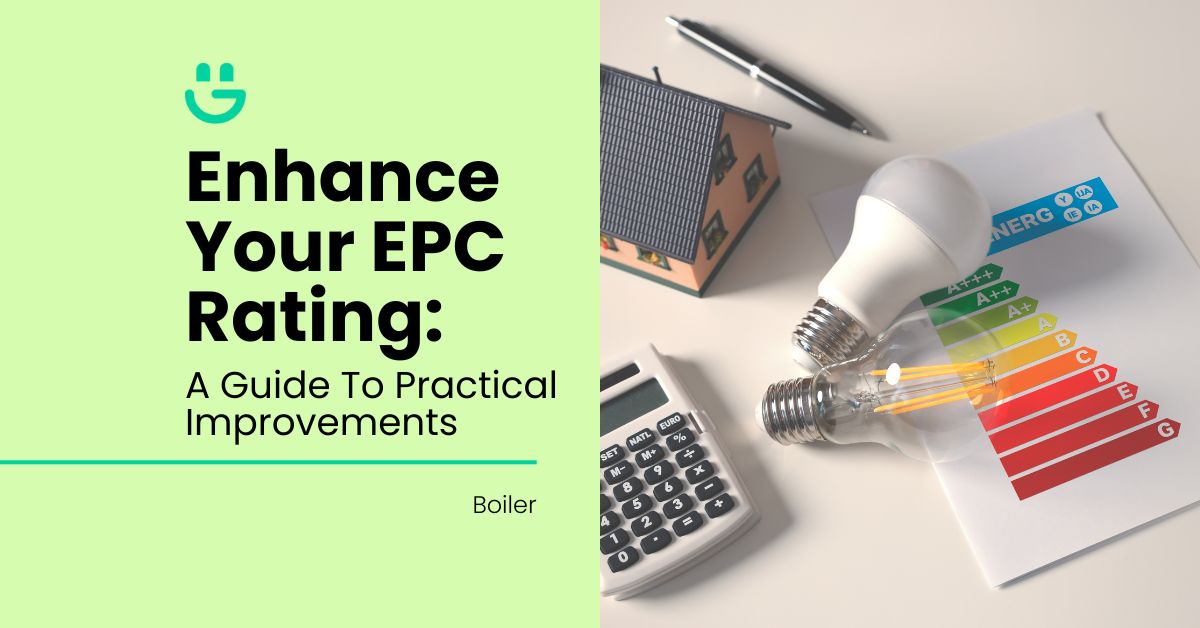Last Updated on January 27, 2025
Introduced in 2007, the EPC (Energy Performance Certificate) isn’t just a handy info card for UK homes. It’s mandatory for any property being sold or rented, highlighting potential energy waste in homes. Unfortunately, UK homes tend to be pretty leaky due to poor insulation. This is the main reason for the gas consumption being twice as much as that of the average EU home.
With the current energy crisis, nobody wants a home that guzzles power. So, most homeowners have now become eager to improve their EPC rating and boost their property’s energy efficiency, saving both the planet and lowering their energy bills.
This guide will focus on practical and cost-effective solutions to improving your EPC rating and lowering carbon emissions.
Contents
6 Ways To Improve Your EPC Rating
Ready to ditch the red and do your part in making your planet and EPC rating greener? Remember, your EPC is your roadmap to a more sustainable future. Familiarise yourself with it and take your first step towards a greener tomorrow!
1. Loft insulation
A house without any insulation is doomed to a low EPC rating. Luckily, this can easily be fixed by installing loft insulation. Did you know that up to 25% of a house’s heat is lost through the roof? It’s a waste of heat and money. By adding 270 mm of quality insulation, you can boost your EPC rating by 10-16 points.
DIY loft insulation
- Prep: Clear the loft, check the joists for damage, and lay crawling boards.
- Measure: Calculate the total area, joist space, and joist height.
- Buy: Choose a loft roll type and thickness based on your measurements.
- Gear up: Make sure your tools are ready, including an insulation cutter, scissors, and protective clothing.
- Between joists: Lay 100 mm of the roll first, then additional layers to reach 270 mm total.
- Over joists: Lay the remaining insulation at a 90° angle over the joists until it’s 270 mm in thickness.
- Loft hatch: Insulate inside the loft hatch and add draught-proof strips.
- Pipes and tank: Insulate pipes with tape-down sleeves, and the hot water tank with a jacket.
Costs
There are different materials that you can choose from for the insulation. So, no matter your budget, you’re guaranteed to find one that works for you. It’s important to note that the cost will also depend on the property type, so the costs mentioned below are rough estimates.
- Blanket/quilt: £400-£700
- Mineral wool: £700
- Sheep’s wool: Most expensive and difficult to install in small spaces
- Spray foam: £40-£90 per square metre
Potential savings
- Up to £600 per year on energy bills for a detached house.
- £400-£500 payback period for installation cost.
Environmental benefits
- Saves 1,000 kg in carbon dioxide equivalent per year (comparable to 50 trees growing for a year).
- Reduces your overall carbon footprint from unnecessarily heating your home.
ECO4 Scheme
Homeowners or renters who have permission from their landlord can apply for the Energy Company Obligation 4 (ECO4) scheme. To qualify, you need to have an EPC rating of E, F or G. The grant will cover insulation up to 270 mm depth, tanks, pipes, draught excluders and walkways. This grant makes loft insulation one of the most cost-effective EPC rating boosters.
2. Lighting upgrades
While lighting alone has a relatively low impact on EPC ratings, choosing energy-efficient LEDs can still contribute positively to your energy savings.
The percentage of energy-efficient lightbulbs in your home will affect the final EPC rating by at least a percentage or two. Therefore, it’s recommended to make the transition from normal light bulbs to LEDs.
Cost savings
- Replacing all bulbs with LEDs can save you £60 per year on electricity bills.
- LEDs last 10 times longer than traditional bulbs, reducing replacement costs.
Best brands
EcoSmart and Philips are both great brands for reliable LED light bulbs.
3. Wall insulation
Apart from the better EPC rating, wall insulation can also keep your home cosy during winter and save you money on your heating bills. With the energy prices currently being so high, it makes it well worth the investment.
The two main categories of wall insulation are cavity and internal, so you need to decide which one will work best for you.
Cavity wall insulation can only be done if you have cavity walls and is the cheaper option. It’s less disruptive and is quick to install. However, you will need a professional to do the installation.
On the other hand, internal, or solid wall, insulation provides insulation for solid walls. The solid wall insulation is the more disruptive of the two to install and will affect the aesthetic of your home and reduce floor space.
Costs
Cavity wall insulation is the most cost-efficient, ranging from £370 to £500 for an average UK home. On the other hand, solid wall insulation doesn’t come cheap at around £100 per square metre of wall.
However, it’s all worth it in the end as you’ll save on energy bills in the long run. Cavity wall insulation can save you around £155 a year, while solid wall insulations will save about £210.
Great British Insulation Scheme (GBIS)
This scheme runs until March 2026. It’s a £1 billion grant that aims to save UK households about £310 per on energy bills. To be eligible, your EPC rating needs to be a D or below and your property has to be located in a lower Council Tax band area.
4. Hot water tank insulation
Hot water cylinder insulation is a crucial step in improving your energy efficiency rating. Hot water tanks constantly use electricity to heat the water, even if it’s not being used. Constantly using electricity to keep the water hot can result in higher energy bills and carbon dioxide emissions.
Your EPC rating will improve by reducing this lost heat by getting a cylinder jacket to increase insulation.
Benefits
By reducing the heat loss from the hot water cylinder, you can:
- Lower your energy bills and save around £70 a year
- Improve your efficiency by maintaining hotter water for longer
- Reduce your carbon footprint
Hot water cylinder jackets are quite affordable, costing around £17.
Installation
- Power down: For electric heaters, flip the breaker switch off.
- Measure & cut: Measure your heater and trim the blanket if needed.
- Wrap & secure: Wrap the blanket around and temporarily tape it in place. Avoid seams landing on side panels.
- Mark the cuts: Use the marker to mark areas for the access panels, pressure relief valves, and pipes.
- Install permanently: Carefully align and tape the blanket securely using permanent tape.
- Power up: Switch your heater back on.
Estimated savings
You should save about 7-16% annually by investing in an insulation jacket.
5. Boiler upgrades
Boilers consume a lot of power, which is why upgrading to a more efficient boiler can improve your EPC rating significantly. You might even jump to an entirely different EPC band or two (for example, from D to E). Old boilers that operate at 65% efficiency can cost you a lot in energy bills, which is why investing in an upgrade with over 90% efficiency is worth it.
Costs
Boilers are pretty expensive, and the total cost will depend on the type of boiler as well as the size.
Boiler Upgrade Scheme:
The Boiler Upgrade Scheme is for homeowners who plan on installing environmentally friendly boilers (heat pump or biomass) on or after 1 April 2022. This new boiler needs to replace a gas, electric or oil boiler (i.e. an energy-inefficient boiler).
6. Double glazing
Windows result in around 30% of heat loss from a home. Thanks to advanced technology, this fortunately no longer needs to be the case. Windows play a significant role in energy efficiency as the more heat escapes through them, the more energy is needed to restore that heat.
Installing double-glazing windows has become significantly popular over the years, and for good reason.
Benefits
- More sound-proof
- Warmer
- More modern look
- Safer
- Easier to clean
- Adds value to the property
Costs
The average cost to install double-glazing windows varies depending on the style of windows, company, etc. In the UK, it will generally cost around £4,640-£5,800 for 8-10 windows. It’s a pretty big investment; however, you can save up to £180 per year on your energy bills and improve your home’s EPC ratings by 3 points. You could also reduce your carbon footprint by 330-405 kg of CO2 per year.
And if you want to go the extra mile, you can even try triple glazing. This means a whole extra pane of glass and an air gap. Upgrading to this from double glazing means you can expect to improve your EPC rating by 60%.
Additional Tips For Energy Efficiency
Apart from the bigger changes, there are also small things you can do to reduce how much energy you use every day. Here are a couple of sustainable living tips:
- Plug it out: Save £55 per year by turning off devices in standby mode.
- Seal the drafts: Weatherproof windows and doors for £95 per year in savings.
- Wash cool & less: Use 30 °C cycles and always wash a full load to save £29 per year.
- Skip the dryer: Air-dry clothes for £60 per year in savings.
- Shorter showers: Keep showers to 4 minutes to save £70 per year.
- Bath less: Swap 1 bath per week for a shower to save £11 per year.
- Kettle smarts: Avoid overfilling kettles and add an aerator to save £36 per year.
- Run a full dishwasher: Reduce use by 1x per week to save £14 per year.
- Energy efficient appliances: Buy appliances with good EPC ratings.
FAQs
What causes a bad EPC rating?
Low EPC ratings often stem from homes lacking efficient heating systems, poorly insulated walls and roofs and lofts, and inefficient appliances.
Will storage heaters improve my EPC rating?
Yes! If you can’t afford to have your walls isolated or your boiler upgraded, there are some new and affordable technologies to help improve your EPC rating, like high-retention storage heaters. Unlike gas central heating, they are capable of storing heat for a long time while releasing it much more slowly.
Should I buy a house with a poor EPC rating?
Buying a house with a low EPC rating requires careful consideration as it can affect your wallet and the environment. In some cases, a mortgage lender may even decline your home loan application altogether if you’re looking to buy a property with a low EPC rating
Conclusion
Every bit counts when working towards a greener future, whether you try easy fixes like switching to LED bulbs or bigger investments like upgrading your boiler or windows. All of these steps will improve your EPC rating, save you money and aid in lower carbon emissions.
So, why is an EPC rating so important? A low EPC means a leaky, energy-guzzling home. In these homes, you’ll typically spend more on your heating bills while contributing to higher carbon emissions. Remember, an energy-efficient home is a comfortable, cost-effective, and environmentally friendly investment in your future. So make the necessary switches today.
Take action for a greener tomorrow and chat to Eco Happy to get expert advice and a quote for energy-efficient home improvements.






James Elston
Boiler Expert
James Elston is the top boiler replacement and heating expert at Eco Happy. He has over 20 years of experience in the industry, focusing on Gas Safe boiler installations and offering home-heating and energy-saving solutions to homeowners across the UK. From sourcing the most energy-efficient combi boiler to providing specialist heating advice, James ensures that Eco Happy maintains the highest standards and best customer service.